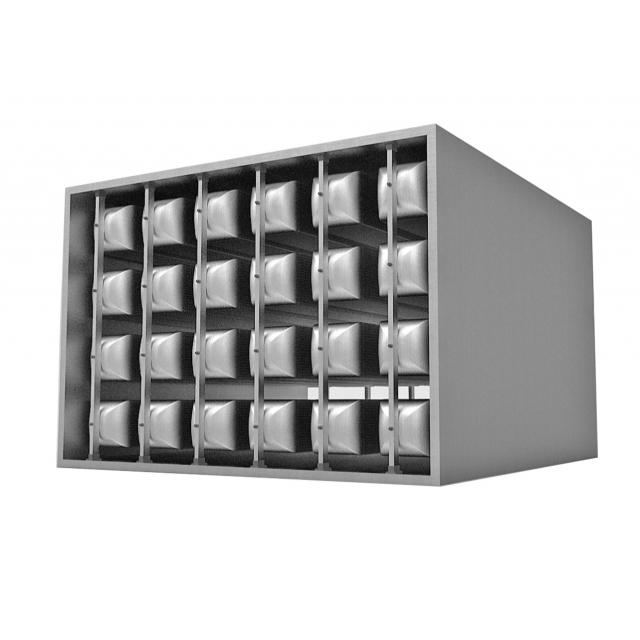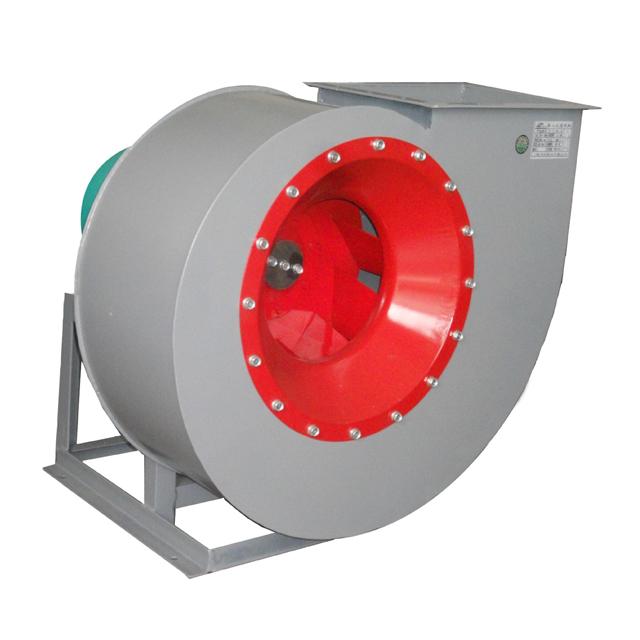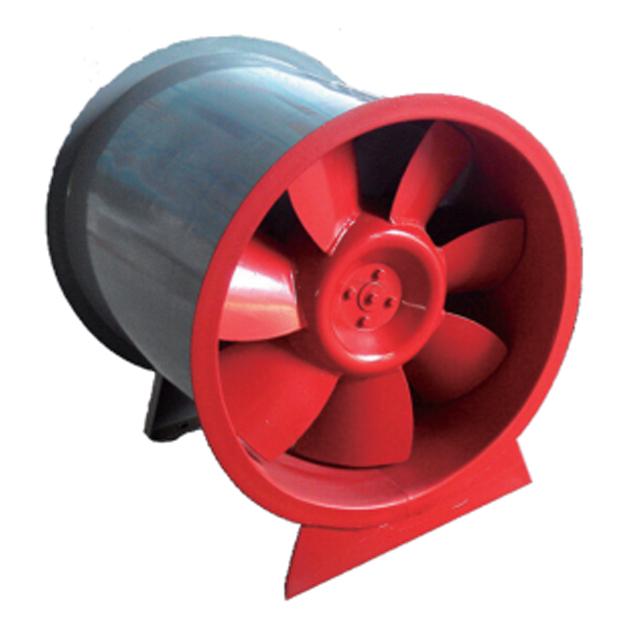How to choose the air outlet in ventilation engineering
In ventilation engineering, the air outlet serves as the key interface between the ventilation system and the indoor space, and its definition and classification are crucial to ensure the ventilation effect. Tuyeres, in short, are openings in ventilation systems, which not only control the flow in and out, but also affect indoor air quality, temperature distribution, and noise levels. According to the different functions and application scenarios, the tuyere can be divided into many types.
First, let's look at the definition of the tuyere. Tuyere, as an important part of the ventilation system, its design should give full consideration to the characteristics of indoor space and ventilation needs. For example, in large commercial buildings, due to the large space and dense personnel, it is necessary to choose a large tuyere with flexible air volume adjustment to ensure smooth air circulation and comfortable indoor environment. In residential buildings, it pays more attention to the concealment and beauty of the tuyere, often using embedded or decorative tuyere design.
Next, we discuss the classification of tuyere. According to the different shape and use, the tuyere can be divided into square tuyere, circular tuyere and linear tuyere. Square vents are widely used in various situations for their simple structure and convenient installation; circular vents are favored for their streamlined design and noise reduction characteristics; and linear vents are suitable for places requiring large areas of air supply or air return, such as large conference rooms and exhibition halls. In addition, there are some special types of tuyere, such as adjustable tuyere, rain-proof tuyere, etc., to meet the ventilation needs of different environments.
Take large shopping centers as an example, shopping centers can use a variety of types of tuyere to meet the ventilation needs of different areas. In the crowded shopping area, the square tuyere with large size and flexible air volume adjustment are selected to ensure smooth air circulation and comfortable indoor environment. In the catering area, the special tuyere with the function of preventing lampblack is selected to avoid the influence of lampblack on the indoor environment. In addition, in public areas such as corridors and staircases, linear air vents are also used for large-area air supply to improve ventilation efficiency.
In the ventilation system, tuyere play a vital role, They are not only the gateway of air circulation, but also the key to achieve the ventilation effect. The reasonable selection and layout of the tuyere can directly affect the overall performance of the ventilation system. Taking a large commercial complex as an example, its ventilation system is designed with full consideration of the functionality of the tuyere. Through the accurate calculation of ventilation demand and air volume, the appropriate size and shape of the tuyere are selected to ensure the smooth and efficient air circulation. At the same time, according to the characteristics of different areas inside the commercial complex, such as densely populated areas and equipment cooling areas, etc., different materials and types of tuyere are adopted to meet the ventilation needs in a specific environment. The reasonable selection and layout of these tuyere not only effectively improves the indoor air quality, but also reduces the energy consumption and noise level, and improves the comfort of the overall environment.
The function of the tuyere in the ventilation system is not only reflected in the air circulation, but also lies in its influence on the airflow distribution, noise control and energy consumption efficiency. In terms of airflow distribution, the layout and quantity of tuyere directly affect the uniformity of air circulation. Through a reasonable tuyere layout, the uniform distribution of indoor air can be realized, to avoid the occurrence of airflow dead Angle or excessive ventilation in local areas. In terms of noise control, the tuyere design and material selection play an important role in reducing the noise level. The air outlet designed with low noise can effectively reduce the noise generated during the operation of the ventilation system and improve the quietness of the indoor environment. In terms of energy consumption efficiency, the size and shape of the tuyere have a direct impact on the energy consumption of the ventilation system. By accurately calculating the required air volume and choosing the appropriate size of the tuyere, we can avoid the energy consumption waste caused by too large or too small air volume.
1.1 Determine the ventilation requirements
In determining the ventilation requirements, we need to consider multiple factors comprehensively. First of all, it is necessary to clarify the types of space served by ventilation engineering, such as office, factory workshop, hospital wards, etc. Different types of space have different requirements for ventilation. For example, hospital wards need to keep the air fresh and clean to prevent cross-infection; and factory workshops need to ensure air circulation to eliminate harmful gases and heat.
1.2 Calculate the required air volume
In the ventilation engineering, the calculation of the required air volume is a crucial link, which is directly related to the efficiency and effect of the ventilation system. Air volume calculation is usually based on the use of the building function, space size, personnel density, equipment heat dissipation and other factors for comprehensive consideration. For example, in the ventilation design of a large office building, we need to first determine the personnel density and equipment heat dissipation of each office, conference room, corridor and other areas, and then use professional air volume calculation software or formula to calculate the air volume required for each area.
In the process of air volume calculation, we should not only consider the basic ventilation needs, but also make flexible adjustment according to the actual situation of the building. For example, in areas with dense personnel and large heat dissipation capacity of equipment, we need to appropriately increase the air volume to ensure air quality and comfort. At the same time, we also need to consider the impact of seasonal changes, indoor and outdoor temperature difference and other factors on the air volume, to ensure that the ventilation system can operate normally under different conditions.
2.1 Selection of air outlet size
In ventilation engineering, the choice of tuyere size is a crucial part. It is not only directly related to the performance of the ventilation system, but also affects the comfort and energy efficiency of the whole space. First, we need to determine the tuyere size according to the ventilation demand and air volume calculation. For example, in a large conference room, if it is expected to accommodate 100 people and if about 50 cubic meters of fresh air per person is needed, the total air volume requirement is 5,000 cubic meters per hour. Based on this data, we can use the principle of fluid dynamics to calculate the wind speed, wind pressure and other parameters to accurately determine the required tuyere size.
When choosing the tuyere size, we also need to consider the influence of the tuyere shape on the airflow distribution. In general, square vents are suitable for most scenarios because they provide a more uniform distribution of airflow. However, in some special cases, such as requiring long-distance air supply or airflow in a specific direction, other shapes of tuyere, such as linear tuyere, may be selected. These vents are designed to ensure that air flow flows in a predetermined path to meet specific ventilation needs.
In addition, the choice of tuyere size also needs to consider the actual installation environment and spatial layout. For example, in narrow corridors or lower ceiling spaces, smaller size vents may need to be selected to avoid occupying too much space. At the same time, we also need to consider the coordination of the tuyere and the surrounding environment, to ensure that it can not only meet the ventilation needs, but also can coordinate with the interior decoration style.
2.2 Influence of air outlet shape
In ventilation engineering, the choice of tuyere shape has a significant impact on the ventilation effect. The shape of the tuyere not only determines the flow mode, but also affects the overall performance of the ventilation system. For example, square air vents are widely used in general building ventilation systems because of their stable structure and easy installation and maintenance. However, on special occasions, such as areas that require precise control of airflow distribution, circular vents may be more appropriate. Circular tuyere can provide a more uniform airflow distribution, reducing eddy currents and dead corners, thus improving ventilation efficiency.
The study shows that the influence of the tuyere shape on the ventilation effect is mainly reflected in the uniformity of the air volume distribution and the noise level. Under the same air volume condition, the circular air outlet can provide a more uniform air volume distribution than the square air outlet, reducing the phenomenon of the local wind speed is too high or too low. This advantage is particularly obvious in large conference rooms, exhibition halls and other occasions that require uniform ventilation. In addition, the noise level of the circular tuyere is also relatively low, helping to create a more peaceful indoor environment.
In practical application, the choice of tuyere shape also needs to consider the building structure and indoor layout. For example, in high-rise buildings, different shapes of tuyere may be needed to meet the ventilation needs of different floors due to the differences in floor height and airflow characteristics. In addition, factors such as interior layout and furniture placement may also have an influence on the choice of tuyere shape. Therefore, when choosing the shape of the tuyere, various factors need to be considered comprehensively to achieve the optimal ventilation effect.
3.1 Consideration of tuyere material
In the ventilation engineering, the consideration of the tuyere material is very important, which is not only related to the durability and service life of the tuyere, but also directly affects the overall performance and operation efficiency of the ventilation system. When selecting the tuyere material, a variety of factors must be considered, such as the use environment, airflow characteristics, maintenance cost, etc.
First of all, using the environment is the primary factor to choose the tuyere material. For example, in a high temperature environment, the tuyere material must have a good high temperature resistance to prevent deformation or damage. Metal materials such as stainless steel and aluminum alloy are commonly used tuyere materials in high temperature environment, which can withstand high temperature and maintain stable performance. In addition, for corrosive environments, such as chemical plants or laboratories, the anticorrosive tuyere materials, such as plastic or special alloys, should be selected to ensure the long-term stable operation of the tuyere.
3.2 Robustness and maintenance costs
In ventilation engineering, the durability and maintenance cost of tuyere are the key factors that cannot be ignored in the selection process. Robustability is directly related to the service life and long-term benefits of the tuyere, while the maintenance cost affects the economy and operation efficiency of the whole ventilation system. When selecting the tuyere, the materials, manufacturing process and use environment must be considered comprehensively to ensure that they have sufficient durability.
First of all, the material of the tuyere is an important factor affecting its durability. Common tuyere materials include aluminum alloy, stainless steel, plastic and so on. Among them, aluminum alloy tuyere has been widely used in ventilation engineering because of its light weight, corrosion resistance and easy processing. Stainless steel tuyere with its high strength, wear resistance, corrosion resistance and other characteristics, in special environment. When selecting materials, suitable materials should be selected according to the specific use environment and requirements to ensure the durability of the tuyere.
Secondly, the manufacturing process is also the key factor affecting the durability of the tuyere. High quality tuyere manufacturing process can ensure the stability of the tuyere structure, sealing, smooth surface, so as to improve its service life and performance. Therefore, when selecting the tuyere, we should pay attention to its manufacturing process and quality control system, and select the products with high-quality manufacturing process and strict quality control system.
The choice and application of tuyere type is crucial in the air conditioning system, which directly affects the circulation, temperature distribution and comfort of indoor air. Here are several common types of tuyere and their applications:
1. Double-layer louver tuyere:
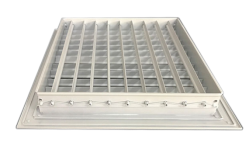
Figure 1 Double-layer louver tuyere
Features: double-layer adjustable blade, can get different air supply distance and different diffusion Angle, can be used as air supply outlet.
Application: widely used in the end of the central air conditioning system, especially for the air supply requirements with guidance function. In addition, it can be used with a multi-leaf control valve to adjust the air volume.
2. Single-layer louver tuyere:
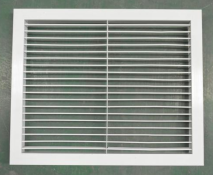
Figure 2 Single-layer louver tuyere
Features: adjustable upper and lower wind direction, the return outlet can be used with the tuyere filter net, the segment Angle can be adjusted.
Application: mainly used for the indoor appearance of fresh air system, exhaust outlet, external wall hole of range hood, etc., to play the role of keeping indoor air fresh, smooth, rain, sand, dust.
3. Fixed strip tuyere:
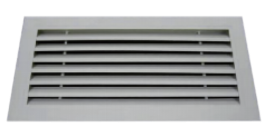
Figure 3. Bar-shaped tuyere
Features: suitable for cooling and heating and air conditioning system, can be installed on the side wall or ceiling.
Application: Spaces that require a uniform distribution of hot and cold air, such as large offices or conference rooms.
4. Self-vertical louver tuyere:

Figure 4 Self-vertical louver tuyere
Features: with positive pressure air conditioning room automatic exhaust function, by the air of the tuyere and natural droop, isolated indoor and outdoor air exchange.
Application: suitable for places requiring automatic exhaust, such as kitchen, bathroom, etc.
5. Scatter tuyere:
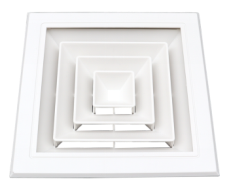
Figure 5 Diter tuyere
Features: it is the commonly used air supply outlet in the air conditioning system, with uniform scattered flow characteristics and simple and beautiful appearance.
Application: suitable for all kinds of places requiring uniform air supply, such as conference rooms, offices, etc.
6. Spherical-adjustable tuyere:
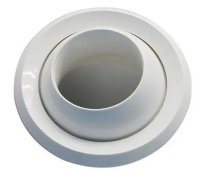
Figure 6 The spherical adjustable tuyere
Features: a nozzle type air outlet, can easily adjust the air injection direction and gas flow.
Application: especially suitable for high layer top high-speed air supply or local cooling occasions, such as airport waiting hall, indoor stadium, etc.
7. Rotary flow tuyere:

Figure 7 Cyling air
Features: to send out the rotating jet, with the characteristics of large induction ratio and fast wind speed attenuation.
Application: in the air conditioning and ventilation system can be used as a large air volume, large temperature difference air supply to reduce the number of tuyere, suitable for various space height and area of the place.
When choosing the tuyere type, the factors to be considered include the structure of the room, the use function, airflow organization, decoration requirements, etc. At the same time, attention should also be paid to the matching of the air outlet and the air conditioning equipment and the rationality of the installation position, so as to ensure the operating effect and indoor comfort of the system.
2.1 Tuyres in a high-temperature environment
In the high temperature environment, the choice of tuyere is particularly important. First of all, we need to consider the material of the tuyere. In a high temperature environment, the tuyere material must be able to resist high temperature and prevent deformation or melting. For example, stainless steels and supertemperature alloys are common options, which are able to maintain stable performance at extreme temperatures. In addition, the design of the tuyere also needs to consider thermal expansion and thermal stress to ensure good sealing and structural integrity under high temperature conditions.
In addition to the material, the size and shape of the tuyere are also the key factors affecting the ventilation effect. In high temperature environments, it may be necessary to choose a larger outlet size in order to increase ventilation. However, excessive tuyere size may lead to uneven airflow distribution and affect the ventilation effect. Therefore, it is necessary to determine the appropriate tuyere size through air volume calculation and simulation. In addition, the choice of the tuyere shape also needs to consider the airflow distribution and the noise level. For example, circular vents usually have lower noise levels, while linear vents are more suitable where a uniform distribution of airflow is required.
In practical application, we can refer to some successful cases to guide the selection of tuyere in high temperature environment. For example, a chemical plant uses a square tuyere made of high temperature resistant alloy in a high temperature workshop, and the size and layout of the tuyere are determined through simulation. After the implementation, the temperature in the workshop is effectively controlled, and the noise level is also kept at a low level. This case shows that in a high temperature environment, the ventilation effect can be significantly improved by reasonably selecting the material, size and shape of the tuyere, and combining with simulation.
2.2 Tuyeres in corrosive environment
In ventilation engineering, when the face of corrosive environment, the choice of tuyere is particularly important. Corrosive environments, such as chemical plants, electroplating workshops, often contain high concentration of corrosive gases or liquids, these substances put forward high requirements on the material and performance of the tuyere. When selecting the tuyere, the corrosion resistance of the material must be fully considered to ensure the long-term stable operation of the tuyere.
For the corrosive environment, the stainless steel tuyere is favored because of its excellent corrosion resistance. Stainless steel tuyere is made of high quality stainless steel material, with a high degree of acid resistance, alkali resistance, salt spray resistance and other corrosion performance, can be long-term stable operation in the harsh corrosive environment. In addition, the stainless steel tuyere also has good sealing and durability, which can effectively prevent the leakage of corrosive gas or liquid, to ensure the safety and reliability of the ventilation system.
2.3 Tuyres in noise-sensitive areas
In ventilation engineering, the selection of tuyere in noise-sensitive areas is particularly important. Noise not only affects people's comfort level, but may also negatively affect the working environment and human health. Therefore, in noise-sensitive areas, such as hospital wards, libraries, conference rooms, etc., choosing low-noise tuyere becomes the key.
First, the noise level of the tuyere should be given priority to the selection of the tuyere in the noise-sensitive areas. According to the national standard, different places have different noise requirements, such as the noise of hospital wards should be controlled below XX decibels. Therefore, when selecting the tuyere, we should check whether the noise level meets the relevant standards, and select the tuyere products with low noise.
Secondly, the shape and material of the tuyere will also affect the noise level. For example, a circular tuyere produces less noise at the same air volume than a square tuyere. In addition, the use of sound-absorbing material tuyere can also effectively reduce the noise. Therefore, in noise-sensitive areas, priority can be given to choose a round or sound-absorbing material tuyere.
















